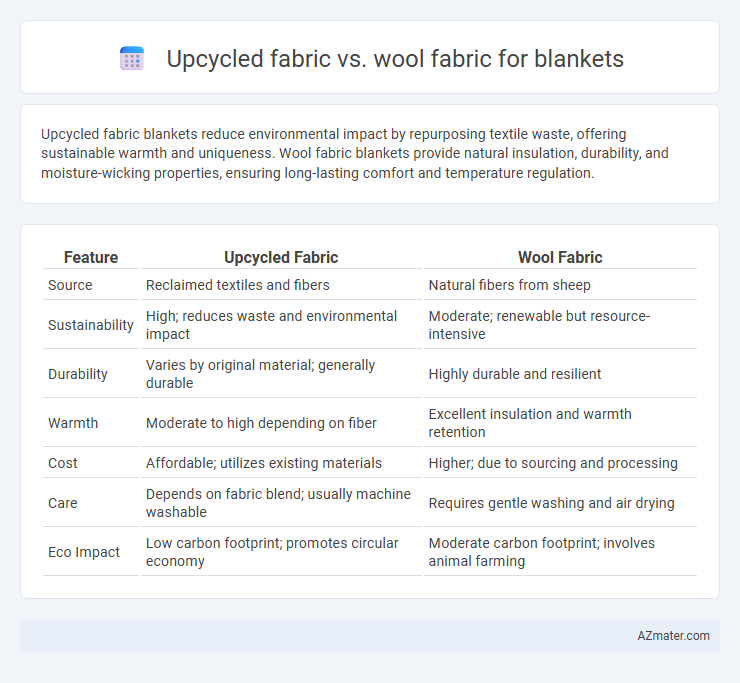Upcycled fabric blankets reduce environmental impact by repurposing textile waste, offering sustainable warmth and uniqueness. Wool fabric blankets provide natural insulation, durability, and moisture-wicking properties, ensuring long-lasting comfort and temperature regulation.
Table of Comparison
| Feature | Upcycled Fabric | Wool Fabric |
|---|---|---|
| Source | Reclaimed textiles and fibers | Natural fibers from sheep |
| Sustainability | High; reduces waste and environmental impact | Moderate; renewable but resource-intensive |
| Durability | Varies by original material; generally durable | Highly durable and resilient |
| Warmth | Moderate to high depending on fiber | Excellent insulation and warmth retention |
| Cost | Affordable; utilizes existing materials | Higher; due to sourcing and processing |
| Care | Depends on fabric blend; usually machine washable | Requires gentle washing and air drying |
| Eco Impact | Low carbon footprint; promotes circular economy | Moderate carbon footprint; involves animal farming |
Introduction to Upcycled and Wool Fabrics
Upcycled fabric is created by repurposing pre-existing textiles, reducing environmental waste while maintaining durability and unique patterns, making it an eco-friendly choice for blankets. Wool fabric, derived from sheep fleece, offers natural insulation, moisture-wicking properties, and long-lasting softness, ideal for warmth and comfort in blankets. Both fabrics provide distinct benefits, with upcycled fabric emphasizing sustainability and wool delivering superior thermal regulation.
Defining Upcycled Fabric for Blankets
Upcycled fabric for blankets involves repurposing pre-existing textile materials, such as discarded garments or fabric scraps, to create sustainable and eco-friendly bedding options. Unlike wool fabric, which is sourced directly from sheep and known for its natural insulation and durability, upcycled fabrics reduce waste and environmental impact by utilizing materials that would otherwise be discarded. This process not only conserves resources but often results in unique, textured blankets with diverse color patterns and sustainable appeal.
What is Wool Fabric?
Wool fabric, derived from the fleece of sheep, is a natural textile known for its excellent insulation, moisture-wicking properties, and durability, making it an ideal choice for blankets that provide warmth and comfort. Unlike upcycled fabrics, which are repurposed from existing materials to reduce waste, wool offers inherent breathability and resilience, maintaining its quality over time even with frequent use. Its ability to regulate temperature and resist odors distinguishes wool fabric from many synthetic or reused alternatives in blanket manufacturing.
Sustainability: Upcycled vs Wool Blankets
Upcycled fabric blankets significantly reduce textile waste by repurposing existing materials, minimizing the demand for new raw resources and lowering overall carbon emissions. Wool blankets, while biodegradable and renewable, involve intensive water usage, methane emissions from sheep, and land degradation during production. Choosing upcycled blankets supports circular economy principles, making them a more sustainable option compared to traditional wool blankets.
Comfort and Softness Comparison
Upcycled fabric blankets offer a unique blend of sustainability and comfort, often featuring a soft, lightweight texture ideal for eco-conscious users seeking gentle warmth. Wool fabric blankets provide superior insulation and natural moisture-wicking properties, delivering exceptional softness with a plush feel that adapts to body temperature. The choice between upcycled and wool fabrics depends on preferences for ethical sourcing and breathability versus traditional warmth and luxurious softness.
Durability and Longevity
Upcycled fabric blankets offer impressive durability due to reinforced stitching and the use of diverse textile blends, often extending the product's lifespan by reducing waste and repurposing strong materials. Wool fabric blankets excel in longevity, benefiting from wool's natural resistance to wear, moisture, and temperature fluctuations, maintaining softness and insulating properties over years of use. Comparing both, wool provides consistent durability with inherent fiber strength, while upcycled fabrics deliver sustainable resilience by maximizing the lifespan of pre-existing materials.
Warmth and Insulation Qualities
Upcycled fabric blankets often vary in warmth and insulation depending on the source materials but generally provide moderate thermal retention with added environmental benefits. Wool fabric blankets excel in warmth and insulation due to natural lanolin content and fiber structure, offering superior moisture-wicking and breathability ideal for cold climates. Wool's ability to trap heat while allowing airflow outperforms many recycled textiles, making it a preferred choice for thermal comfort.
Allergies and Skin Sensitivity
Upcycled fabric blankets often contain synthetic fibers or mixed materials that may trigger allergic reactions or irritate sensitive skin due to chemicals or residues from previous use. Wool fabric blankets, while natural and breathable, can cause itching or exacerbate conditions like eczema in individuals sensitive to lanolin or wool fibers. Choosing hypoallergenic, untreated wool or certified organic upcycled fabrics can help minimize skin irritation and allergy risks.
Price and Availability
Upcycled fabric blankets are generally more affordable due to the reuse of existing materials, resulting in lower production costs and increased availability in eco-conscious markets. Wool fabric blankets, while often pricier, offer durability and natural insulation, but their availability can fluctuate depending on wool supply and seasonal factors. Consumers seeking budget-friendly and sustainable options usually find upcycled fabric more accessible compared to the higher-priced, premium wool blankets.
Which Blanket Fabric Suits Your Needs?
Upcycled fabric blankets offer eco-friendly benefits by repurposing textile waste, often resulting in unique patterns and breathable comfort ideal for sustainable living. Wool fabric blankets provide superior warmth, natural insulation, and moisture-wicking properties, making them perfect for colder climates or those seeking durable, long-lasting softness. Choosing between upcycled and wool blankets depends on prioritizing environmental impact or thermal performance to suit your specific comfort and lifestyle needs.

Infographic: Upcycled fabric vs Wool fabric for Blanket
 azmater.com
azmater.com